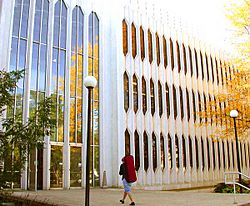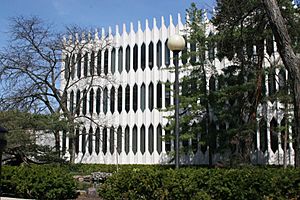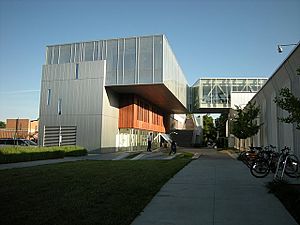Oberlin Conservatory of Music facts for kids

Musician entering the Oberlin Conservatory
|
|
| Type | Private music conservatory |
|---|---|
| Established | 1865 |
|
Parent institution
|
Oberlin College |
| Dean | William Quillen |
|
Academic staff
|
88 |
| Students | 615 |
| Location |
,
,
United States
41°17′29″N 82°13′10″W / 41.291402°N 82.219407°W |
| Website | http://www.oberlin.edu/conservatory |
The Oberlin Conservatory of Music is a special music school. It's part of Oberlin College, which is a private college in Oberlin, Ohio. It started way back in 1865. This makes it the second oldest music school in the United States that has been open all this time! It's unique because it's fully connected to a college that teaches many different subjects. This means students can study both music and other subjects at the same time. They can even get two degrees in five years! Most students at the Conservatory are undergraduates, meaning they are working on their first college degree.
Contents
History of Oberlin Conservatory
Oberlin College began in 1833. The Oberlin Conservatory of Music started in 1865. Two years later, in 1867, the Conservatory officially joined the college.
Oberlin was special because it was the first college and music school in the U.S. to regularly accept African-American students. This happened even before the Civil War. A famous student, William Grant Still, who graduated from Oberlin, became known as the "dean of African-American composers." Oberlin continues to value freedom, fairness, and helping others.
Oberlin Conservatory is also the oldest music school that has always taught both boys and girls. This is because it joined Oberlin College, which was the first college to teach both boys and girls. The college and conservatory were named a National Historic Landmark in 1965. This was because of their important role in social progress.
Oberlin Conservatory also played a part in the start of electronic music. This is because of its connection to Elisha Gray, who invented an early electronic sound device, and Thaddeus Cahill, who invented the telharmonium. The TIMARA program (Technology In Music And Related Arts) started in 1967. It was the first program of its kind at a music school anywhere in the world.
In 2009, the Oberlin Conservatory received the National Medal of Arts. This is the highest award the U.S. government gives to artists and people who support the arts. Oberlin Conservatory is the only professional music school to receive this honor from President Barack Obama.
How to Join Oberlin Conservatory
Students can apply to join only the Conservatory. Or, they can apply for Oberlin's special five-year Double-Degree program. In this program, students earn two degrees: a Bachelor of Music and a Bachelor of Arts.
Getting into the Conservatory is very competitive. More than 1,400 musicians from all over the world apply each year. Only about 120 new students are accepted. Admission mostly depends on a very strong audition.
Buildings and Facilities
The Conservatory is located in four buildings that are connected. These buildings are on the south side of Tappan Square. The first three large white buildings were designed by a Japanese-American architect named Minoru Yamasaki in 1963. His design for these buildings looks a lot like his later design for the World Trade Center in New York City. In 2010, the buildings were made taller. This improved the sound quality inside and added a new recital room.
In 2010, The Bertram and Judith Kohl Building opened. This building was designed by the DLR Group. It is now home to the Jazz Studies, Music History, and Music Theory departments. The Kohl Building is connected to the Robertson Building by a bridge on the third floor. This bridge also has the Sky Bar, named after a famous jazz club.
The Robertson Building has about 150 practice rooms. Most of these rooms have windows. This building also holds the Otto B. Schoepfle Vocal Arts Center. You can also find the Career Resource Center and the Kulas Organ Center here. There are also rooms for making reeds, computer labs, and faculty offices.
Oberlin has been an "all-Steinway" school since 1877. This means they use only Steinway & Sons pianos. They have one of the largest collections of Steinway pianos in the world, with over 240 pianos.
What Students Study
Oberlin Conservatory offers private lessons in 31 different areas. Students can choose from many undergraduate majors. This includes a special double major in piano performance and vocal accompanying.
Students can earn a Bachelor of Music degree. They can also get a Master of Music degree. Other options include a performance diploma or an artist diploma. Students accepted into both the College of Arts and Sciences and the Conservatory can join the double-degree program. This lets them earn a degree from each part of Oberlin.
The programs are organized into four main departments:
- Department of Contemporary Music
- Department of Performance
- Department of Historical Performance
- Department of Musicology
Oberlin Jazz Ensemble
The Oberlin Jazz Ensemble is made up of students who study jazz and classical music. It is part of a four-year program in jazz studies. Students in this program can earn a bachelor of music degree. They can focus on performing, composing, or both.
Wendell Logan was a professor of African-American Music. He was also the head of the Oberlin Jazz Studies Program. He started the Oberlin Jazz Ensemble in 1973.
Some famous members of the Ensemble include:
- Ben Jaffe '93
- Chris Jonas '88
- Michael Mossman '82
- Chris Eldridge '04
- Peter Evans '03
- Sullivan Fortner '08
Notable People from Oberlin
Faculty
Alumni
Images for kids
See also
- List of colleges and university schools of music in the USA




